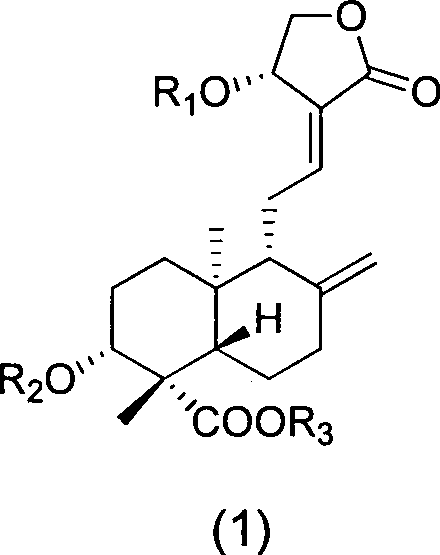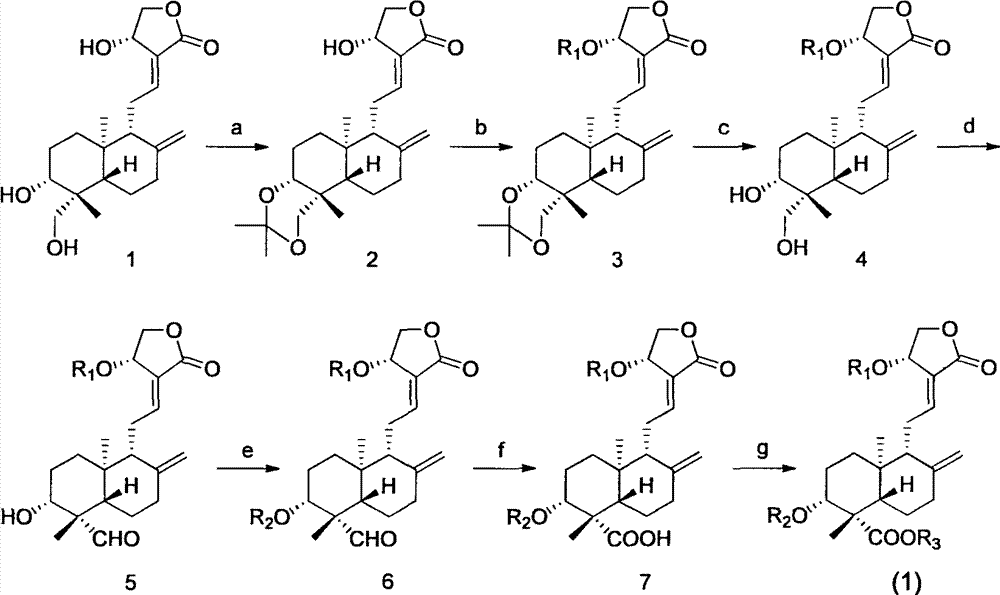19-carboxyl andrographolide derivative, preparation method and medicinal application thereof
A technology of andrographolide and its derivatives, which is applied in the fields of antineoplastic drugs, drug combinations, organic chemistry, etc., and can solve problems such as unstable physical and chemical properties of andrographolide, and destruction of the lactone ring structure
- Summary
- Abstract
- Description
- Claims
- Application Information
AI Technical Summary
Problems solved by technology
Method used
Image
Examples
Embodiment 1
[0051] 3, Preparation of 19-isopropoxy-andrographolide:
[0052] Dissolve andrographolide (10.00g, 28.54mmol) in dry toluene / DMSO (200ml / 27ml), add 2,2-dimethoxypropane (14ml), p-toluenesulfonic acid (catalytic amount), 80°C Stir for about 1.5 hours until the reaction is complete, cool to room temperature, add triethylamine (7ml) to quench the catalyst, add toluene (150ml) to the reaction solution and wash with water (3×300ml), separate the organic layer, and dry over anhydrous sodium sulfate. Concentrate the dry organic phase, add diethyl ether (30ml), stir, filter and dry with suction to obtain white solid particles (10.36g, 26.53mmol, yield 93%). 1 H-NMR (300MHz, CDCl 3 , ppm) δ: 6.96 (1H, t, J=6.4Hz, H-12), 5.03 (1H, d, J=5.9Hz, H-14), 4.91 (1H, s, H-17a), 4.63 ( 1H, s, H-17b), 4.48-4.43 (1H, dd, J=10.4Hz, 6.1Hz, H-15a), 4.28-4.24 (1H, dd, J=1.9Hz, 10.4Hz, H-15b) , 3.97 (1H, d, J=5.8Hz, H-19a), 3.52-3.48 (1H, dd, J=3.4Hz, 8.4Hz, H-3), 3.2 (dd, 1H, H-19b), 2.64 -2.40(4H...
Embodiment 2
[0054] Preparation of 14-O-acetyl-andrographolide:
[0055] 3,19-isopropoxy-andrographolide (7.00g, 17.93mmol), Ac 2 O (60ml) was refluxed at 142°C for about 1.5 hours until the reaction was complete, cooled to room temperature, added a small amount of water and an appropriate amount of sodium bicarbonate powder and stirred until no bubbles overflowed, diluted the reaction solution with dichloromethane (100ml), and separated the organic layer And washed with saturated sodium bicarbonate solution (3X120ml) and saturated brine (3X120ml) successively. The organic phase is directly concentrated without drying, and then the concentrated crude product 3,19-isopropoxy-14-acetyl-andrographolide is dissolved in an aqueous solution of acetic acid (acetic acid: water=28ml: 12ml) at room temperature, and the reaction After completion, add sodium bicarbonate powder and stir until no bubbles overflow, dilute the reaction solution with dichloromethane (80ml), separate the organic layer and ...
Embodiment 3
[0057] Preparation of 14-O-acetyl-19-formyl-andrographolide:
[0058] 14-O-acetyl-andrographolide (5.00g, 12.74mmol) was dissolved in dichloromethane (130ml), and TEMPO (0.10g, 064mmol), potassium carbonate-carbonic acid with a pH of about 9 were added successively under an ice bath. Sodium hydrogen buffer solution (130ml), TBAI (0.24g, 0.65mmol) and NCS (2.40g, 17.97mmol), stirred vigorously for about 9 hours until the reaction was complete. After the reaction was complete, the organic layer was separated, the aqueous layer was extracted with dichloromethane (2×100ml), the organic layer was washed with saturated brine (2×300ml), and dried over anhydrous sodium sulfate. The dry organic phase was concentrated and separated by column chromatography (petroleum ether: ethyl acetate = 2:1) to finally obtain a dry pale yellow foamy substance (4.52 g, 11.57 mmol, yield 91%). mp: 60-61°C. 1 H-NMR (300MHz, CDCl 3 , ppm) δ: 9.77 (1H, s, H-19), 7.01 (1H, t, J=6.8Hz,, H-12), 5.92 (1H, ...
PUM
 Login to View More
Login to View More Abstract
Description
Claims
Application Information
 Login to View More
Login to View More - R&D
- Intellectual Property
- Life Sciences
- Materials
- Tech Scout
- Unparalleled Data Quality
- Higher Quality Content
- 60% Fewer Hallucinations
Browse by: Latest US Patents, China's latest patents, Technical Efficacy Thesaurus, Application Domain, Technology Topic, Popular Technical Reports.
© 2025 PatSnap. All rights reserved.Legal|Privacy policy|Modern Slavery Act Transparency Statement|Sitemap|About US| Contact US: help@patsnap.com



